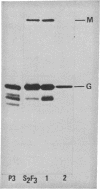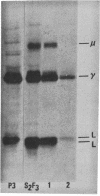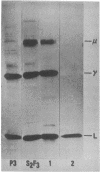Abstract
B leukemia cells from four different patients were hybridized with a mouse myeloma cell line with polyethylene glycol as a fusing agent. The original leukemia cells all expressed immunoglobulin on their surface, but failed to secrete it. Over 200 different human-mouse somatic cell hybrids were obtained; 57% of them secreted human immunoglobulin in large amounts. Human immunoglobulin secretion can be a stable property of these hybrid cells over months of continuous culture. In each case the human immunoglobulin secreted was restricted to the light chain type expressed by the parental B leukemia cell. In addition, these hybrid cells secreted the original mouse myeloma protein and a variety of mixed human-mouse immunoglobulin molecules.
Full text
PDF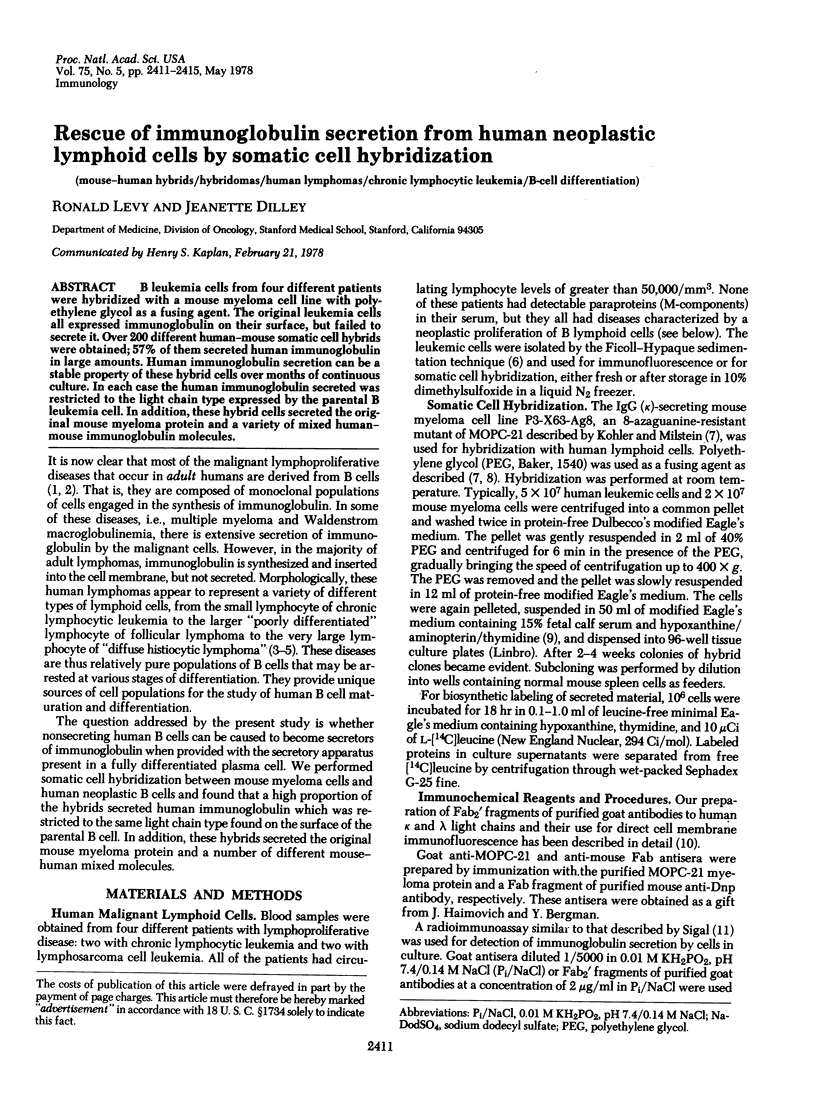
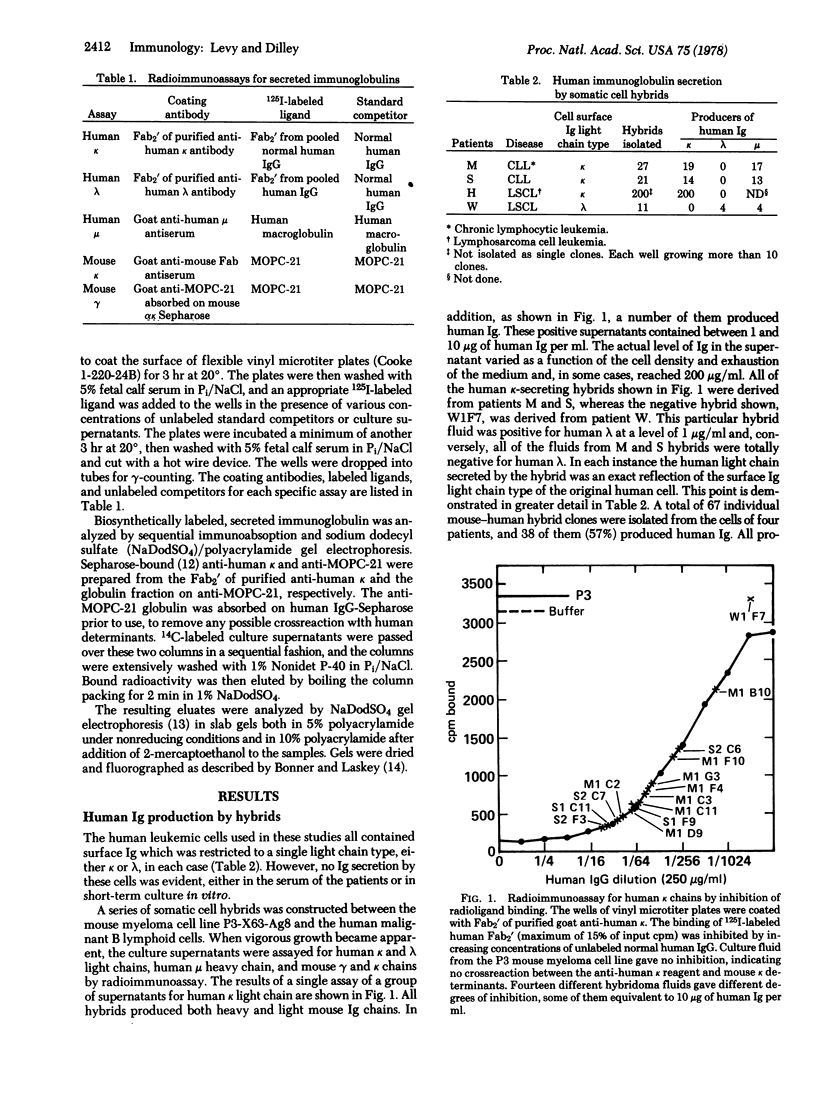
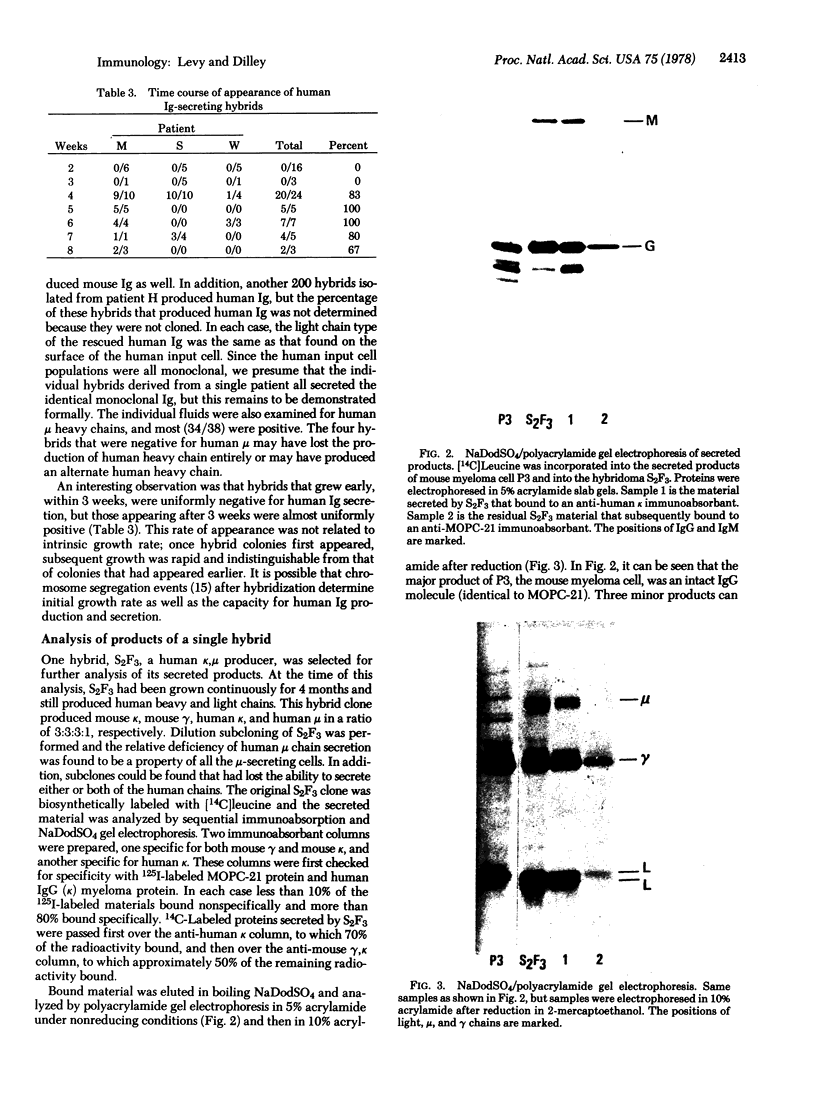
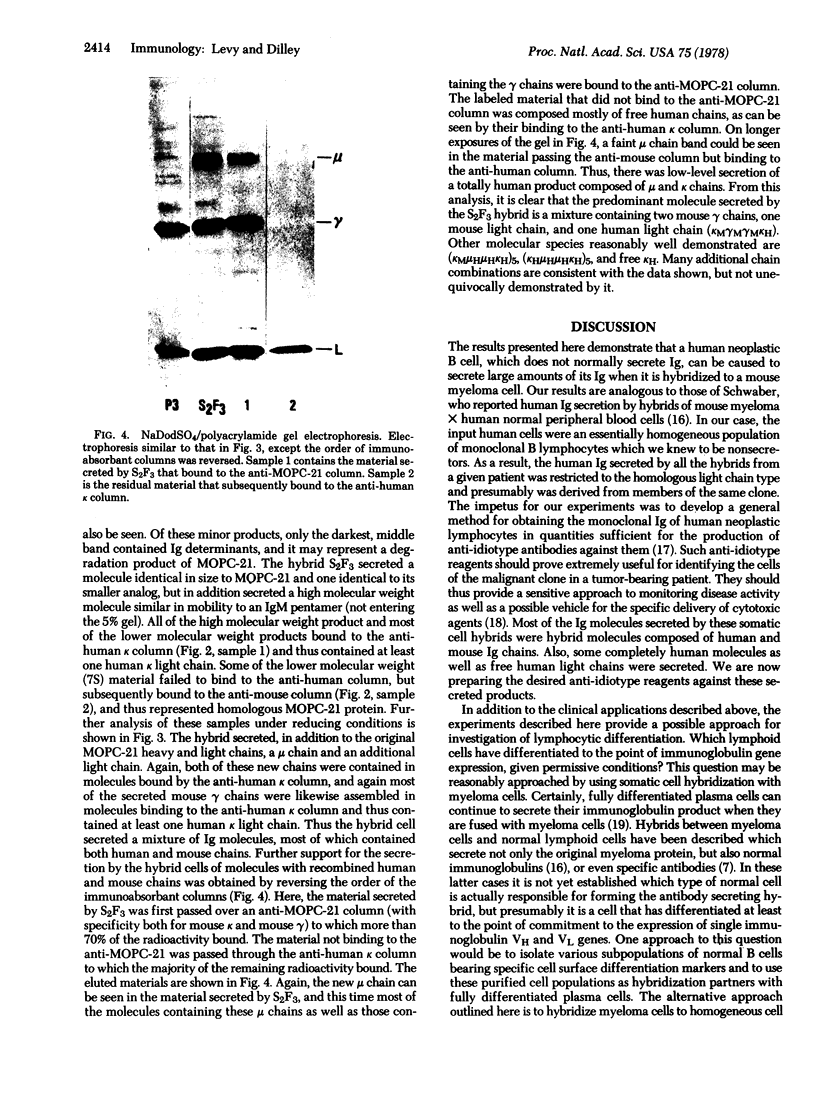
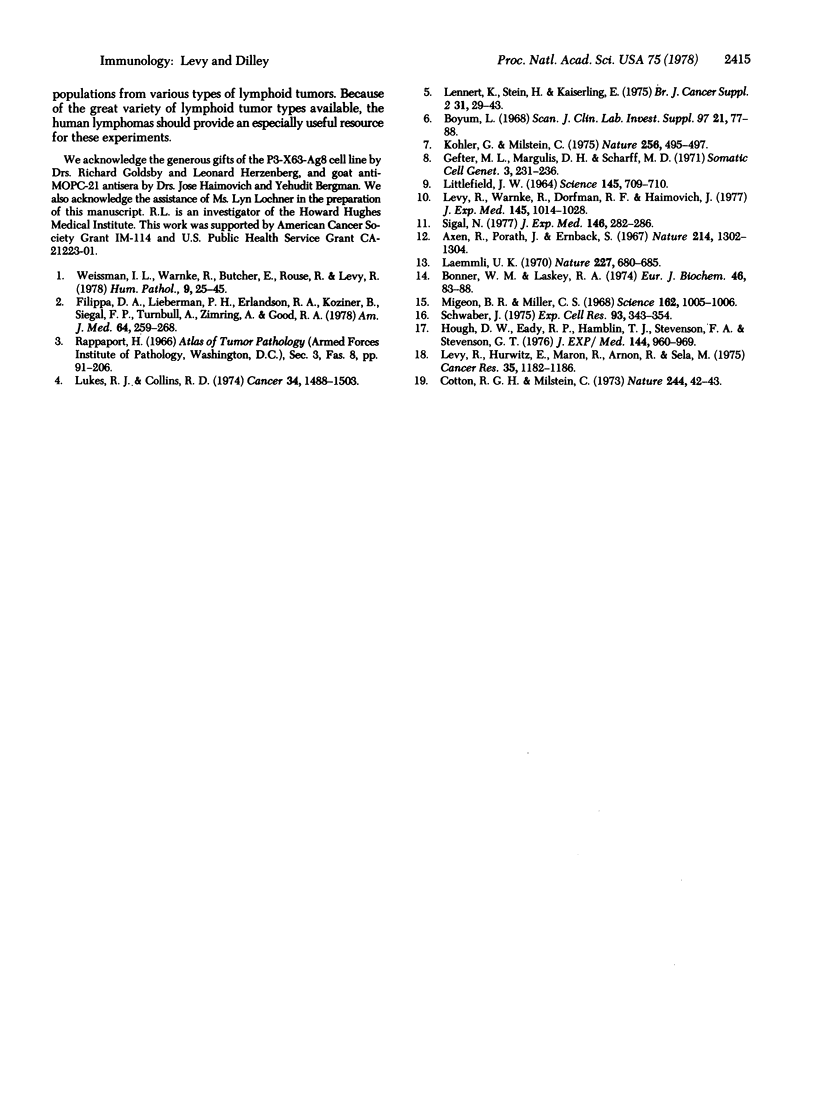
Images in this article
Selected References
These references are in PubMed. This may not be the complete list of references from this article.
- Axén R., Porath J., Ernback S. Chemical coupling of peptides and proteins to polysaccharides by means of cyanogen halides. Nature. 1967 Jun 24;214(5095):1302–1304. doi: 10.1038/2141302a0. [DOI] [PubMed] [Google Scholar]
- Bonner W. M., Laskey R. A. A film detection method for tritium-labelled proteins and nucleic acids in polyacrylamide gels. Eur J Biochem. 1974 Jul 1;46(1):83–88. doi: 10.1111/j.1432-1033.1974.tb03599.x. [DOI] [PubMed] [Google Scholar]
- Cotton R. G., Milstein C. Letter: Fusion of two immunoglobulin-producing myeloma cells. Nature. 1973 Jul 6;244(5410):42–43. doi: 10.1038/244042a0. [DOI] [PubMed] [Google Scholar]
- Filippa D. A., Lieberman P. H., Erlandson R. A., Koziner B., Siegal F. P., Turnbull A., Zimring A., Good R. A. A study of malignant lymphomas using light and ultramicroscopic, cytochemical and immunologic technics: correlation with clinical features. Am J Med. 1978 Feb;64(2):259–268. doi: 10.1016/0002-9343(78)90054-2. [DOI] [PubMed] [Google Scholar]
- Gefter M. L., Margulies D. H., Scharff M. D. A simple method for polyethylene glycol-promoted hybridization of mouse myeloma cells. Somatic Cell Genet. 1977 Mar;3(2):231–236. doi: 10.1007/BF01551818. [DOI] [PubMed] [Google Scholar]
- Hough D. W., Eady R. P., Hamblin T. J., Stevenson F. K., Stevenson G. T. Anti-idiotype sera raised against surface immunoglobulin of human neoplastic lymphocytes. J Exp Med. 1976 Oct 1;144(4):960–969. doi: 10.1084/jem.144.4.960. [DOI] [PMC free article] [PubMed] [Google Scholar]
- Köhler G., Milstein C. Continuous cultures of fused cells secreting antibody of predefined specificity. Nature. 1975 Aug 7;256(5517):495–497. doi: 10.1038/256495a0. [DOI] [PubMed] [Google Scholar]
- LITTLEFIELD J. W. SELECTION OF HYBRIDS FROM MATINGS OF FIBROBLASTS IN VITRO AND THEIR PRESUMED RECOMBINANTS. Science. 1964 Aug 14;145(3633):709–710. doi: 10.1126/science.145.3633.709. [DOI] [PubMed] [Google Scholar]
- Laemmli U. K. Cleavage of structural proteins during the assembly of the head of bacteriophage T4. Nature. 1970 Aug 15;227(5259):680–685. doi: 10.1038/227680a0. [DOI] [PubMed] [Google Scholar]
- Lennert K., Stein H., Kaiserling E. Cytological and functional criteria for the classification of malignant lymphomata. Br J Cancer Suppl. 1975 Mar;2:29–43. [PMC free article] [PubMed] [Google Scholar]
- Levy R., Hurwitz E., Maron R., Arnon R., Sela M. The specific cytotoxic effects of daunomycin conjugated to antitumor antibodies. Cancer Res. 1975 May;35(5):1182–1186. [PubMed] [Google Scholar]
- Levy R., Warnke R., Dorfman R. F., Haimovich J. The monoclonality of human B-cell lymphomas. J Exp Med. 1977 Apr 1;145(4):1014–1028. doi: 10.1084/jem.145.4.1014. [DOI] [PMC free article] [PubMed] [Google Scholar]
- Lukes R. J., Collins R. D. Immunologic characterization of human malignant lymphomas. Cancer. 1974 Oct;34(4 Suppl):suppl–suppl:1503. doi: 10.1002/1097-0142(197410)34:8+<1488::aid-cncr2820340822>3.0.co;2-c. [DOI] [PubMed] [Google Scholar]
- Migeon B. R., Miller C. S. Human-mouse somatic cell hybrids with single human chromosome (group E): link with thymidine kinase activity. Science. 1968 Nov 29;162(3857):1005–1006. doi: 10.1126/science.162.3857.1005. [DOI] [PubMed] [Google Scholar]
- Schwaber J. Immunoglobulin production by a human-mouse somatic cell hybrid. Exp Cell Res. 1975 Jul;93(2):343–354. doi: 10.1016/0014-4827(75)90459-0. [DOI] [PubMed] [Google Scholar]
- Sigal N. H. Novel idiotypic and antigen-binding characteristics in two anti-dinitrophenyl monoclonal antibodies. J Exp Med. 1977 Jul 1;146(1):282–286. doi: 10.1084/jem.146.1.282. [DOI] [PMC free article] [PubMed] [Google Scholar]
- Weissman I. L., Warnke R., Butcher E. C., Rouse R., Levy R. The lymphoid system. Its normal architecture and the potential for understanding the system through the study of lymphoproliferative diseases. Hum Pathol. 1978 Jan;9(1):25–45. doi: 10.1016/s0046-8177(78)80005-7. [DOI] [PubMed] [Google Scholar]



